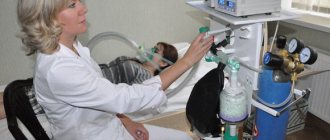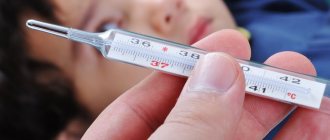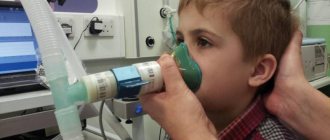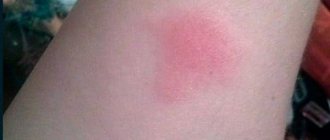How many days after illness can a child be vaccinated?
As a rule, starting from the third day of life, infants receive vaccinations designed to provide protection against the most dangerous diseases. For maximum effectiveness, a special vaccination calendar has been developed.
If the baby suddenly becomes ill, the immunization procedure is postponed for a certain period. Any vaccination is allowed only when the child is completely healthy and his immunity is sufficiently stable.
Therefore, it is necessary to determine how long after the illness immunoprophylactic injections can be administered so that they do not lead to serious undesirable consequences.
It is important to consider that the timing may vary for different types of vaccinations and diseases.
After ARVI
The term ARVI refers to a number of acute inflammatory diseases of the respiratory system that develop as a result of exposure to pneumotropic viruses. Quite often, a viral disease is complicated by a bacterial infection.
Any acute respiratory viral disease has a negative impact on well-being, weakening the immune system and disrupting the body’s functioning. It is necessary that the child’s body is fully restored and strengthened before the upcoming vaccination.
Depending on the severity of ARVI, the recovery period can last up to four weeks on average.
If the baby had a common cold, accompanied by a slight cough and runny nose, vaccination can be carried out within five to seven days from the moment of recovery. But after the flu or a severe sore throat, it will take at least thirty days for complete recovery and restoration of the body.
After whooping cough
Whooping cough is one of the most dangerous acute infectious diseases, which is transmitted by airborne droplets and is characterized by a long course. Most doctors insist that at least two weeks must pass after an illness before the vaccination procedure.
After whooping cough, you can get vaccinated no earlier than 2 weeks
After chickenpox and other diseases accompanied by fever
If the baby has been diagnosed with diseases such as chickenpox, rubella, measles or other conditions characterized by an increase in temperature, it is necessary that at least thirty days pass from the moment of recovery to the date of vaccination. In some cases, an even longer period may be required.
Vaccination against polio
Currently, there are active discussions on the topic of how necessary it is for a child to be vaccinated at an early age. There are opinions both for and against vaccination. In order to make an informed decision, you need to thoroughly study the problem. Turning to statistics and looking at reviews from parents, we see that the reaction of children to the polio vaccine is almost always positive.
There are exceptional cases that fall into the category of “contraindications”. At the same time, after complete vaccination by the age of 14, the risk of contracting this dangerous disease is reduced to almost zero.
What is polio?
Poliomyelitis is a virus, it is highly contagious, transmitted by airborne droplets and the fecal-oral route. It can be contracted at the household level through touching objects or contact with carriers of the disease. In the external environment, the virus is quite stable and can live in some cases for 2-4 months.
A total of 3 types of the disease have been identified.
Most often, children under 7 years old catch polio, but you can become infected at any age if you have contact with a carrier and do not have the necessary immunity. Poliovirus multiplies in the oral mucosa and intestines and then attacks the gray matter of the spinal cord. Complications can lead to paralysis and even death.
This disease has existed for quite a long time. Outbreaks of epidemics often claimed large numbers of lives. To counter frequent epidemics, 2 types of vaccines were developed, after which cases of mass infection with the virus decreased significantly.
Symptoms and consequences
Diagnosing polio is quite difficult, especially in its mild manifestations. If you have a cough, runny nose, or fever, you may mistake this illness for the flu or a cold. Main symptoms:
- elevated temperature;
- cough;
- runny nose;
- gastrointestinal disorder;
- headache;
- vomit;
- convulsions;
- pain in muscles and spine;
- paresis;
- paralysis.
Thus, effective diagnosis of polio is possible only after the effects of the virus on the nervous system are discovered.
Prevention and treatment
There is no specialized treatment for polio. Therefore, disease prevention becomes an important task. The main preventive measure is vaccination, in other words, vaccination against polio. With timely vaccination after 14 years of age, a child may not be afraid of contracting this disease. But do not forget about basic hygiene rules, and also that there are contraindications to the use of vaccination.
Contact with those who are known to be contagious is very dangerous. Especially in people with weakened immune systems, unwanted complications may occur. Parents, after the child has received the drug, need to be extremely careful, as there is a chance of becoming infected themselves, especially if drops are used for oral vaccination.
Types of vaccinations
At the moment, clinics provide 2 types of vaccinations. In 1952, virologist Jonas Salk developed an inactivated vaccine. It contains chemically inactivated polioviruses enclosed in a formaldehyde solution. After 3 doses of the vaccine, 99% of people acquire the appropriate antibodies and eliminate the risk of future infection. The vaccine is administered subcutaneously or intramuscularly. All 3 types of poliovirus are introduced. The vaccinated patient may be infectious and pose a risk to people with HIV. Such contact has consequences - vaccine-associated polio.
Another scientist, Albert Sabin, weakened the polio virus, resulting in a variant in which the polio virus reproduces within the intestinal tract but cannot move elsewhere, such as into cells of the nervous system. After 3 oral treatments, 95% of people develop stable immunity. The vaccine is in the form of drops. The child receives them on the tip of the tongue, so the virus enters the oral mucosa and then into the intestines. The vaccine contains all 3 known types of polio.
Vaccination procedure
Inactivated polio vaccine contains killed virus, so your child cannot get vaccine-associated polio.
A local reaction in the form of redness on the skin and a slight fever is possible. This cannot be seen as a complication. But still, any vaccination is a load on the immune system. This means that the child should be healthy on the day of taking the drug. Even with a simple runny nose, a negative reaction can occur. If an elevated temperature is also noticed, this is a contraindication for the procedure on that day.
The first dose can be given at 3 months. A total of 3 procedures are needed with a break of 1.5 months. The last vaccination is carried out at 14 years of age. This version of the drug has good reviews among doctors and parents. If you complete the full course after 14 years of age, no further vaccination is required, and complications will not occur, even if there is contact with a carrier of the virus.
How many days after a course of antibiotic treatment can I get vaccinated?
For some types of diseases, it is customary to prescribe therapy using antibiotics. These drugs are dangerous due to their harmful effects not only on harmful, but also on beneficial microflora.
In this regard, the body will need complete and effective recovery before vaccination.
This period is quite long and can last for two or three months.
Contraindications
The hepatitis B vaccination schedule for adults is drawn up by the staff of the medical clinic, taking into account possible adverse reactions from the vaccine and contraindications. Thus, the hepatitis B vaccine is contraindicated for children and adults in the following cases:
- If the patient experiences an exacerbation of chronic diseases, acute infections and other pathologies. In this case, the injection is given only after the person has completely recovered.
- If vaccination is carried out after the birth of the child, but his weight does not reach 2 kg, the procedure should be postponed until his body weight normalizes.
- The list of side effects for adults includes allergies and undergoing several courses of chemotherapy, when the protective functions of the immune system are greatly reduced. Under such circumstances, vaccination is carried out only after a couple of months.
- Other contraindications for adults include a number of immunodeficiency conditions, such as cancer, AIDS, pregnancy, and blood diseases.
In addition, the vaccine cannot be given if the patient has had acute exacerbations and side effects in the past, or has an individual intolerance to the components.
How long after vaccination can I get other vaccinations?
In order for the administered injections to have maximum effect and not cause the slightest harm to the body, certain intervals must be observed between vaccination procedures. They differ depending on the type and purpose of vaccinations.
The first three doses of DTP (adsorbed pertussis-diphtheria-tetanus vaccine) must be administered at intervals of at least 35-40 days. After this, repeated vaccinations can be done at least after 28-29 days.
If the child is sick or there are any other contraindications to immunization, this procedure must be postponed. The exact timing is determined by the doctor individually.
DPT vaccine
HBV vaccination, intended to protect against hepatitis B, is carried out in three stages - immediately after birth, then at one month and at six months. This regimen is standard, but for some reasons the injection may be postponed.
In this case, certain rules must be taken into account. Between the first and second vaccination, the maximum interval is 12 weeks, and the third vaccine must be administered no later than one and a half years after the first injection.
BCG (vaccination against tuberculosis) must be carried out separately from other vaccinations. The time interval between vaccinations should be at least thirty days. The only exception is the hepatitis B vaccine (HBV), which must be given one to two days before BCG.
Starting from the age of three months, the baby must be vaccinated against polio. Such vaccinations must be done until the baby turns four years old.
According to the new vaccination schedule, there must be a 6-week gap between the two injections.
The third vaccination must be given at age 16 to strengthen immunity to polio.
The diphtheria and tetanus vaccine ADS should be administered twice at a 30-day interval. If the baby suddenly falls ill, this period increases. Afterwards, revaccination is carried out with an injection of ADS-toxoid. If there are contraindications to this drug, ADS-M-anatoxin is used. In this case, two doses must be administered at a 45-day interval.
The trivaccine, designed to protect the baby from measles, rubella and mumps, is administered for the first time at the age of one year. And then at six years of age a mandatory revaccination is carried out. It is possible to combine this vaccination with other vaccines, with the exception of BCG.
You should always keep in mind that the interval between vaccinations is affected by the general well-being of the child. Therefore, before each immunization procedure, they must undergo a thorough examination by a doctor.
Is it possible to get vaccinated if you have a runny nose?
Vaccination against tuberculosis, along with vaccination against mumps, rubella and measles, is a very serious test for a child’s immune system. In the process of developing immunity from dangerous diseases, the body can react very violently - children’s temperature rises, their general condition worsens, and sometimes disorders in the gastrointestinal tract are observed.
Therefore, if a child is already suffering from a runny nose or cold, then vaccination will only aggravate the condition of a weakened body. As a result, the side effects can become very acute and unpleasant, and negatively affect the child’s health in the future.
Photo 1. A runny nose is not a clear contraindication to vaccination, but in case of allergies or acute respiratory viral infections, it is better to refuse BCG.
There is another important reason forbidding BCG for colds and runny nose. The disease forces the child’s immune system to devote all its strength to fighting the infection, and he simply may not react to the tuberculosis bacillus introduced into the body. This is not dangerous to health, but the child will not develop immunity to tuberculosis, which means that vaccination will be done in vain.
But you can do a Mantoux test with a runny nose, since infection with passive microorganisms does not occur.
Attention! If a runny nose is caused by teething or a mild reaction to a strong smell and dust, and is not associated with the child’s weakened immune system, then there are no obstacles to vaccination against tuberculosis.
Possible consequences of receiving a vaccine for a runny nose
If a runny nose is caused by ARVI and is accompanied by fever and general malaise, then after BCG administration the temperature . An already weakened body will weaken even more, as a result of which bronchitis, flu or even severe pneumonia . A simple weakening of the immune system may also occur, due to which the child will suffer from frequent colds, stomatitis and other similar problems.
If a runny nose occurs as a symptom of an allergic reaction, the child can easily develop asthma, bronchitis or laryngitis.
Moreover, if the problem is not addressed in time, the disease will become chronic and will interfere with the child for the rest of his life.
If the child’s immunity is weakened, a complication such as regional lymphadenitis, sometimes even with purulent manifestations, develops much more often. Usually the lymph nodes in the armpit area (where the injection was given) become inflamed. In the future, relapses of inflammation and regular lymphadenitis are possible.
Video on the topic
Dr. Komarovsky on when vaccination should not be carried out:
Vaccination against various diseases is carried out according to a clear schedule, however, due to colds or other pathological conditions, vaccination may be postponed. In order to ensure the most effective and safe prevention, it is allowed to vaccinate a baby only if he is absolutely healthy.
After recovery, an average of two to four months should pass before vaccination. During this period, the child’s body will be able to strengthen, recover and gain strength.
Indications for vaccination
There are a number of indications for vaccination against hepatitis B. First of all, it should be given to adults who were not vaccinated as children.
Children are vaccinated immediately after birth, with the exception of young patients with severe contraindications. After a few months (6 or 12), re-vaccination is done, but its effectiveness does not exceed 5-6 years.
What do you think are the most important factors when choosing a medical facility?
Adults receive an injection based on individual indications. The vaccine is administered in medical centers at the place of residence or at work, where there is an appointment at a professional clinic. This service is also provided in private clinics.
The following patients are at risk:
- People who live under the same roof with infected virus carriers or patients.
- Medical students and other medical staff.
- Patients with dangerous chronic diseases who constantly face blood transfusions.
- People who have not been vaccinated before.
- Adults who have been in contact with sick people.
- People working with blood-based products.
- Oncohematological patients.











